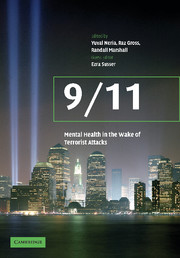Book contents
- Frontmatter
- Contents
- Acknowledgments
- Editors brief bio
- List of contributors
- Foreword
- Part I Introduction
- Part II The psychological aftermath of 9/11
- Part III Reducing the burden: community response and community recovery
- Part IV Outreach and intervention in the wake of terrorist attacks
- Part IV A New York area
- 16 PTSD in urban primary care patients following 9/11
- 17 Project Liberty: responding to mental health needs after the World Trade Center terrorist attacks
- 18 Mental health services support in response to September 11: the central role of the Mental Health Association of New York City
- 19 The New York Consortium for Effective Trauma Treatment
- 20 Evaluation and treatment of firefighters and utility workers following the World Trade Center attacks
- 21 The World Trade Center Worker/Volunteer Mental Health Screening Program
- 22 Child and adolescent trauma treatments and services after September 11: implementing evidence-based practices into complex child services systems
- 23 Relationally and developmentally focused interventions with young children and their caregivers in the wake of terrorism and other violent experiences
- Part IV B Washington, DC
- Part IV C Prolonged-exposure treatment as a core resource for clinicians in the community: dissemination of trauma knowledge post-disaster
- Part V Disasters and mental health: perspectives on response and preparedness
- Index
19 - The New York Consortium for Effective Trauma Treatment
from Part IV A - New York area
Published online by Cambridge University Press: 27 October 2009
- Frontmatter
- Contents
- Acknowledgments
- Editors brief bio
- List of contributors
- Foreword
- Part I Introduction
- Part II The psychological aftermath of 9/11
- Part III Reducing the burden: community response and community recovery
- Part IV Outreach and intervention in the wake of terrorist attacks
- Part IV A New York area
- 16 PTSD in urban primary care patients following 9/11
- 17 Project Liberty: responding to mental health needs after the World Trade Center terrorist attacks
- 18 Mental health services support in response to September 11: the central role of the Mental Health Association of New York City
- 19 The New York Consortium for Effective Trauma Treatment
- 20 Evaluation and treatment of firefighters and utility workers following the World Trade Center attacks
- 21 The World Trade Center Worker/Volunteer Mental Health Screening Program
- 22 Child and adolescent trauma treatments and services after September 11: implementing evidence-based practices into complex child services systems
- 23 Relationally and developmentally focused interventions with young children and their caregivers in the wake of terrorism and other violent experiences
- Part IV B Washington, DC
- Part IV C Prolonged-exposure treatment as a core resource for clinicians in the community: dissemination of trauma knowledge post-disaster
- Part V Disasters and mental health: perspectives on response and preparedness
- Index
Summary
INTRODUCTION
From the first chaotic days after the attacks of September 11, 2001, the co-directors of the Consortium – Marylene Cloitre, PhD, Spencer Eth, MD, Randall Marshall, MD, and Rachel Yehuda, PhD – shared a collective sense of alarm that the need for mental health services in our community would greatly exceed capacity to provide evidence-based treatment for trauma-related problems and disorders. Because federal programs almost exclusively emphasize the public health objective of restoring the general population to a semblance of normal functioning, we worried that there would not be adequate programs devoted to helping persons developing serious psychiatric disorder as a result of the attacks. Subsequent epidemiological studies (reviewed in this volume) confirmed our impression, but by the time these data were available – many months after 9/11 – we were already well underway with the project of providing intensive training to a group of clinicians at each of our centers, who could then serve as expert treatment providers, and, more importantly, clinician experts available to the community for educational programs. In sum, the Consortium was a rapidly implemented large-scale project with the overall objective of disseminating evidence-based treatments for trauma-related disorders to the greater New York community.
During the first year alone, approximately 920 patients were evaluated and treated at all sites. Treatment was provided in English, Spanish, Hebrew, German, Korean, and several Chinese dialects. Some sites developed intensive trainings for clinicians, and other focused on clinical work or other kinds of educational programs (e.g. intensive training and supervision for a small group of community clinicians).
- Type
- Chapter
- Information
- 9/11: Mental Health in the Wake of Terrorist Attacks , pp. 311 - 332Publisher: Cambridge University PressPrint publication year: 2006



